Welcome to our Colossus Movie Guide for Apocalypse Now. This guide contains everything you need to understand the film. Dive into our detailed library of content, covering key aspects of the movie. We encourage your comments to help us create the best possible guide. Thank you!
What is Apocalypse Now about?
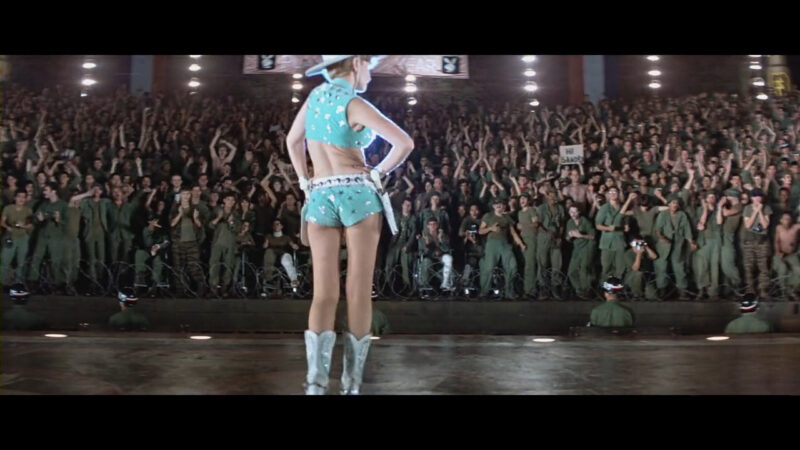
Apocalypse Now explores the fragile human psyche when its morality is challenged and its sanity is questioned—a psychological focus wrapped in the grim tapestry of the Vietnam War. Instead of a mere anti-war narrative, this Best Picture nominee at the 52nd Academy Awards probes deeper, manifesting as a timeless allegory of man’s inner conflict with himself and his role in events much bigger than himself. The river journey undertaken by Willard serves as a metaphorical journey into his own subconscious, paralleling the descent into darkness and chaos that consumes him as he inches closer and closer to Kurtz—a man who will serve as Willard’s final test as he tries to gain control of his sanity.
The film wrestles uncomfortable topics such as the paradox of war and the blurred lines between civilization and savagery. The film, which famously won the Palme d’Or after premiering unfinished at the Cannes Film Festival, questions the conventional wisdom that war, in all its grimness, is a necessary evil in the pursuit of “civilization.” It forces us to confront the disturbing reality that, beneath the thin veneer of social norms, human beings are capable of immense cruelty and chaos. Through its dark and unsettling narrative, Apocalypse Now vividly illustrates that the “apocalypse” isn’t an external catastrophe, but an internal collapse of humanity’s moral compass. Willard’s journey personifies that struggle as he tries to make sense of the war and his place within it.
Movie Guide table of contents
Cast
- Martin Sheen – U.S. Army Captain Benjamin Willard
- Marlon Brando – Colonel Walter Kurtz
- Robert Duvall – Lieutenant Colonel William “Bill” Kilgore
- Frederic Forrest – Engineman 3rd Class Jay “Chef” Hicks
- Albert Hall – Chief Petty Officer George Phillips
- Sam Bottoms – Gunner’s Mate 3rd Class Lance B. Johnson
- Laurence Fishburne – Gunner’s Mate 3rd Class Tyrone “Mr. Clean” Miller
- Dennis Hopper – an American photojournalist
- G. D. Spradlin – Lieutenant General R. Corman
- Jerry Ziesmer – Jerry Moore
- Harrison Ford – Colonel G. Lucas
- Scott Glenn – Captain Richard M. Colby
- John Milius – Writer
- Francis Ford Coppola – Writer and director
The ending of Apocalypse Now explained
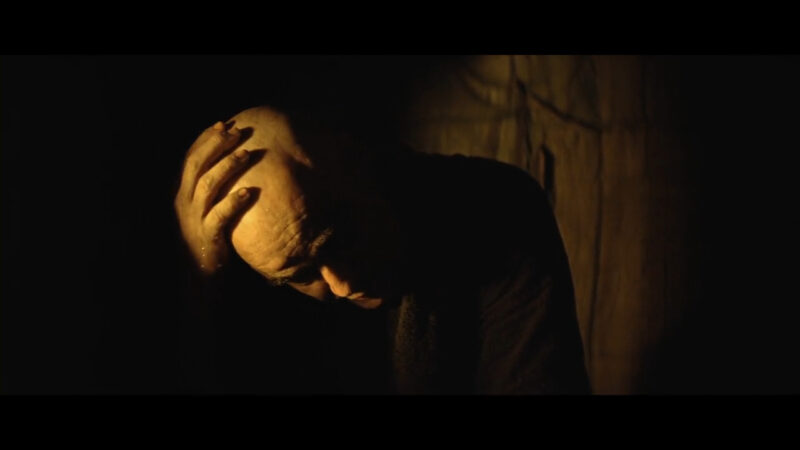
A recap of the ending
The chaotic and stressful filming of the ending of Apocalypse Now has been a story of Hollywood intrigue for years. If you want more insight into Coppola’s labor-intensive production of the film, be sure to check out the documentary Hearts of Darkness: A Filmmaker’s Apocalypse.
The PBR crew glides into the desolate heart of Colonel Kurtz’s outpost—an abandoned Angkor temple now teeming with indigenous Montagnards. The temple grounds are a chilling sight, littered with the grisly remains of victims, a stark testament to the power Kurtz holds over this corner of the jungle.
Willard, Chef, and Lance disembark from the boat, the weight of their mission hanging heavily in the air. They are greeted by an eccentric American photojournalist, a seeming acolyte of Kurtz, who lauds Kurtz’s genius in feverish tones. Amid the chaos, they come across Colby, a previous would-be assassin of Kurtz, now reduced to a near-catatonic state—a chilling reminder of their mission’s high stakes.
With Lance at his side, Willard ventures deeper into the compound, leaving Chef behind with specific orders: call in an airstrike if they fail to return, effectively annihilating the outpost.
Inside the compound, Willard is brought before the elusive Kurtz, who is shrouded in shadows, his voice echoing around the gloomy room. In a sinister move, Kurtz imprisons Willard and eventually places Chef’s severed head into his lap, a ghastly sight that successfully prevents the called airstrike.
Once released, Willard becomes a captive audience to Kurtz’s chilling monologues. Kurtz praises the Viet Cong’s ruthlessness and shares tales of his family back home, imploring Willard to tell his son about him once he’s dead.
Under the shroud of the night, as the Montagnards engage in a ceremonial slaughter of a water buffalo, Willard stealthily infiltrates Kurtz’s chambers. The compound echoes with the sounds of the ceremony and the death throes of the buffalo as Willard raises his machete and delivers the fatal blow, ending Kurtz’s reign of terror.
Willard emerges from the compound, a manuscript of Kurtz’s writings tucked under his arm. The sight of him sends the Montagnards into a state of reverence, and they bow down to him, acknowledging his dominance. Ignoring the gestures, Willard collects Lance, a lost soul in the middle of chaos. They board the PBR, turning its nose away from the temple, away from the Montagnards left in disarray. The boat pushes off, churning the water as it retraces its path down the river, leaving the horrors of the outpost behind. We hear Kurtz whisper “the horror” repeatedly as they float away.
The symbolic meeting of Willard and Kurtz
Meeting Kurtz represents the culmination of Willard’s journey into the “heart of darkness.” We’ll use that phrase several times throughout this piece because the movie is In fact loosely based on the 1899 novella Heart of Darkness by Joseph Conrad. The book follows an introspective sailor named Marlow during his journey up the Congo River to meet an idealistic man named Kurtz. Eventually, Marlow finds out that Kurtz has established himself as a “god” among the natives. Ultimately, as Sparknotes notes, “Marlow is forced to align himself with either the hypocritical and malicious colonial bureaucracy or the openly malevolent, rule-defying Kurtz, it becomes increasingly clear that to try to judge either alternative is an act of folly: how can moral standards or social values be relevant in judging evil? Is there such thing as insanity in a world that has already gone insane?”
If you’ve seen Apocalypse Now, that should all sound familiar, and perfectly set the stage for Willard’s meeting with Kurtz. This moment is not just about confronting Kurtz as a man but confronting what he symbolizes: the deepest, darkest recesses of the human psyche when exposed to the brutality of war. The encounter highlights the internal struggle that Willard has been grappling with throughout his mission: how to navigate the thin line between savagery and civilization, madness and sanity.
The conversation between Willard and Kurtz is revelatory. Kurtz’s monologues touch upon the themes of the duality of man and the nature of war. They reveal the transformation of a once noble officer into a being that embodies the primal instincts of mankind—aggression, dominance, survival at any cost. The encounter with Kurtz pushes Willard to question his own understanding of war, morality, and humanity.
The visual representation of Kurtz, bald and shrouded in shadows, further intensifies the meaning of this encounter. The baldness can be interpreted as a symbol of Kurtz’s raw exposure to the brutalities of war, stripped of any pretense or shield. He stands as a stark embodiment of the destructive transformation that war can precipitate in a man. While the shadows visually represent the obscurity and complexity of the themes being explored. Kurtz, much like the core themes of the film, is not easily understandable or definable. He exists in a moral gray area, a space that is neither entirely light nor entirely dark. This visual portrayal suggests that the exploration of the human condition in the context of war isn’t black and white—it’s filled with shades of gray.
Kurtz and the water buffalo
The intercutting of the killing of Kurtz and the water buffalo in Apocalypse Now heightens the symbolism and impact of Willard and Kurtz’s meeting. The water buffalo’s slaughter represents a ritualistic, primitive act of violence, resonating with the primitive instincts within mankind and serving stark reminder of the brutal, primal nature of violence, an aspect that is paralleled in the act of war represented throughout the movie.
Simultaneously, the killing of Kurtz by Willard represents a different, albeit equally brutal, form of violence. While Willard’s act is borne out of a military order, the act itself takes on a personal, intimate nature as he battles his own inner demons. The killing of Kurtz can be seen as a symbolic act of slaying the manifestation of the darkest aspects of humanity, a manifestation brought forth by the atrocities of war.
Intercutting these two acts of violence underscores the cyclical nature of violence and provides a reflection on the theme of duality—the savagery in civilization and the civilization within savagery. The brutal killing of the water buffalo in a ritualistic manner contrasts starkly with the reasoned, sanctioned killing of Kurtz. Yet, both acts stem from the same primal instinct—to kill.
Willard stands as a god

There are two ways to read the moment where Willard emerges from killing Kurtz to a crowd of Montagnards that bow to him—a darker reading, and a more hopeful reading. Let’s start with the first reading, which argues for Willard’s descent into savagery, and finish with a reading that argues Willard transcends the darkness. In truth, both readings can exist at the same time, depicting a complicated picture of the psychological turmoil of war.
Reading #1: Willard succumbs to savagery
The act of bowing down to Willard, the new master of the compound, is striking in its suggestion of deification. Throughout the film, Kurtz has been portrayed as a kind of god, ruling over his own self-made domain outside the traditional rules of society. By stepping into Kurtz’s role, Willard assumes this god-like status. This moment speaks to the desire for and danger of absolute power—it is seductive and destructive at the same time. It blurs the lines between leader and tyrant, man and god.
Willard, who was initially on a mission to end Kurtz’s reign, finds himself in the very place Kurtz once stood. It suggests that anyone, given certain circumstances, can become a Kurtz, losing sight of their moral compass and becoming masters of their own, often destructive, domains. It underscores the notion that we all carry within us the capacity for good and evil.
The face statues scattered around Kurtz’s compound have been used throughout the film as motifs representing the timeless nature of human savagery. As Willard stands amid these statues in the final scene, they serve as silent witnesses to the cyclical nature of power and the propensity for violence. They bear witness to the transformation of Willard into a figure akin to Kurtz, suggesting the universality and timelessness of this cycle of savagery and power.
Willard’s journey throughout the film has been one of transformation, where he confronts not only Kurtz but also his inner darkness. The completion of his mission does not bring a sense of triumph but rather an unnerving realization of his potential for savagery. Killing Kurtz and stepping into his position suggests the completion of his descent into the “heart of darkness,” emphasizing the film’s exploration of the blurry line between civilization and savagery, sanity and madness.
Reading #2: Willard transcends the darkness
Considering the final scene of Apocalypse Now from the perspective of Willard’s transcendence over the darkness paints a different picture. This shift in interpretation suggests that by killing Kurtz, Willard doesn’t become another version of him, but instead, he rejects the path that Kurtz had taken, thereby asserting his own agency and humanity.
Kurtz, for much of the film, represents the extreme effects of war—how it can break a man and lead him to embrace the most savage aspects of humanity. Willard’s mission to kill Kurtz symbolizes his personal battle with these very same forces. Kurtz’s death, then, can be seen as Willard’s rejection of this potential within himself. He confronts his own “heart of darkness” and overcomes it, suggesting an act of personal catharsis.
When Willard stands on the landing, amid the face statues and the bowing followers, he indeed assumes a god-like status—but not in the vein of Kurtz. He doesn’t revel in power for power’s sake. Instead, he represents a different kind of god who has faced the abyss, wrestled with his darker instincts, and has chosen a different path. He emerges not as a ruler, but as an enlightened individual who has mastered his own inner demons.
By choosing to take Lance back home, Willard affirms his humanity and compassion. He rejects the cycle of violence and madness that Kurtz was trapped in. This act is a powerful reaffirmation of his humanity and a rejection of the dehumanizing effects of war. The face statues that have been present throughout the ending serve as silent observers to this act of transcendence. They bear witness to a different outcome than Kurtz’s, a deviation from the path of savagery and towards a reclaiming of one’s humanity.
The themes and meaning of Apocalypse Now
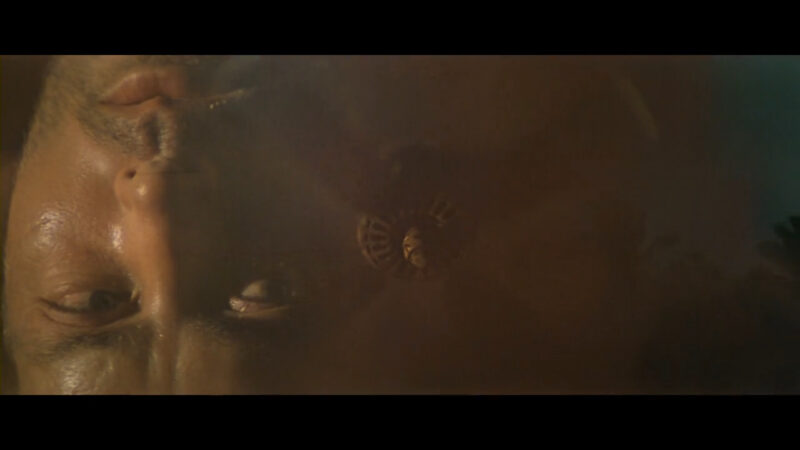
The duality of man
As heavily discussed in the ending section, one of the most prominent themes in Apocalypse Now is the exploration of the duality of man, specifically the conflict between savagery and civilization. The film investigates this concept by positioning its characters in extreme situations that prompt introspection about their inherent nature and moral compass. (Portraying this darkness while filming in the Philippines gave Sheen a near-fatal heart attack.)
The journey up the river towards Kurtz is a journey into the heart of darkness—not just in a geographic or physical sense, but also in a psychological and moral sense. It presents a metaphorical descent into the primal instincts that exist within humanity. Willard, who starts as a disillusioned soldier, must grapple with his growing understanding of the complexities and contradictions of the human condition as he ventures deeper into the jungle. He recounts his trying verbatim through narration (read from an article written by war correspondent Michael Herr), which makes the filmic experience all the more intimate.
Kurtz, a renegade Special Forces officer, encapsulates this duality. He was once a decorated military officer, a paragon of civilized society. However, the brutality and savagery of war push him to discard his previous beliefs and embrace a primitive lifestyle, showing how quickly one can descend into the other under extreme circumstances.
The duality of man also extends to the soldiers, whose jovial camaraderie and youthful innocence are interspersed with scenes of rampant destruction and casual violence. They, too, represent the contradiction within man—a capacity for both innocence and brutality.
The absurdity of war
Apocalypse Now repeatedly presents war not as a noble endeavor but as an absurd, chaotic, and dehumanizing event. It critiques the bureaucracy and political machinations that often underpin warfare and highlights the destructive effect it has on the human psyche.
The film is replete with scenes that underscore the senselessness and chaos of war. For instance, the attack on the Vietnamese village, orchestrated merely so that the soldiers could surf in peace, epitomizes the bizarre juxtaposition of everyday trivialities with the stark reality of violence. Similarly, the destruction and subsequent rebuilding of the bridge (a prominent motif in the film) every night is an exercise in futility that serves to underscore the absurdity of the war. This cyclical, pointless act highlights the wastefulness and meaningless nature of the conflict.
Kurtz’s monologues provide a biting critique of the bureaucracy and politics of war. His disillusionment and descent into madness stem from the hypocrisy and absurdity he perceives in the conduct of the war.
The journey of self-discovery
As Willard travels upriver towards Kurtz, he is forced to confront not just the physical dangers of the jungle and the war, but also his own psychological and moral uncertainties. Willard’s journey is a metaphor for introspection and self-understanding. As he learns more about Kurtz and the horrifying actions he has undertaken, Willard is compelled to reflect on his own morality and his role in the war.
The river, as a motif, symbolizes this journey into the self. It serves as a physical and metaphorical pathway leading Willard towards self-awareness and understanding. As he ventures deeper into the jungle and further from civilization, he confronts the darkest aspects of his personality and the horrifying realities of the war.
This theme of self-discovery is culminated in the final scene, where Willard must decide whether to become a new Kurtz or to reject this path of darkness. The choice he makes is emblematic of his journey of self-discovery and his grappling with the moral and psychological complexities of his character.
Why is the movie called Apocalypse Now?
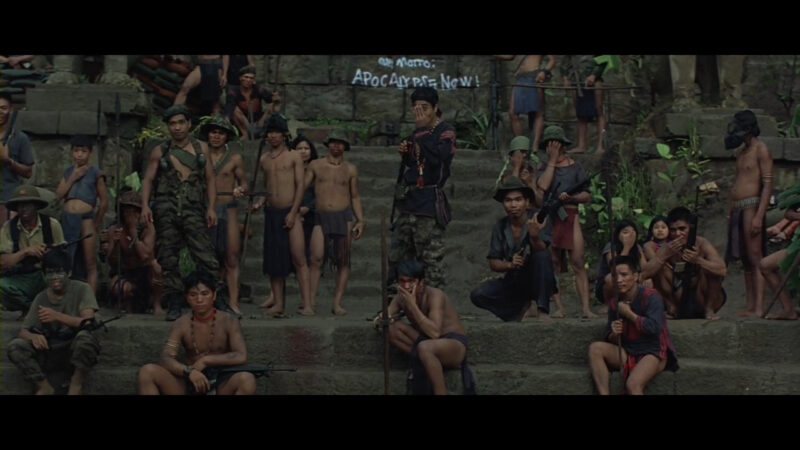
The title Apocalypse Now is a powerful piece of the film’s intricate puzzle, immediately invoking a sense of impending doom and chaotic finality. However, its meaning transcends mere end-of-the-world scenarios common in literature and cinema. The “Apocalypse” isn’t a physical, cataclysmic event, but rather, a psychological and moral Armageddon. It signifies the fracturing of human sanity and morality, illustrating the turmoil within one’s psyche when thrust into war.
The psychological apocalypse of war
“Apocalypse” originates from the Greek word ‘apokalupsis’, meaning an “unveiling” or “revelation.” Traditionally associated with religious texts, especially the Book of Revelation in the New Testament, it suggests an unveiling of truths previously hidden or obscured. In the context of Apocalypse Now, the title signifies the unveiling of the darker aspects of human nature, forcing both characters and viewers to confront uncomfortable truths about morality, sanity, and civilization.
The word “Now” in the title adds a layer of immediacy and urgency to this revelation. The apocalypse isn’t a distant future event, but a present reality, unfolding “now.” This temporal placement invites viewers to consider the ongoing struggle between civility and savagery within the human psyche. It suggests that the apocalypse is not necessarily a future, cataclysmic event, but a potential present-day reality, given the right—or wrong—circumstances.
In context, the title Apocalypse Now insinuates that war—in this case, the Vietnam War—acts as the catalyst, prompting this psychological and moral apocalypse. War’s brutality and senselessness strip away civilization’s polished exterior, revealing the inherent chaos and violence. It serves as a stage where the protagonist’s journey into his own psyche parallels the outer journey into the heart of war, manifesting the idea that war is not only an external conflict but also an internal struggle within the self.
The title challenges conventional perspectives on war and civilization. By presenting the apocalypse as a current state, it contests the notion that war, despite its horrors, leads to societal advancement or is a necessary evil in the path of “civilization.” Instead, it proposes that war pushes individuals and societies towards moral and psychological apocalypse. The darkness and chaos of war, therefore, are not anomalies, but inherent aspects of civilization itself, laid bare by the stressors of conflict.
The title also suggests the pervasiveness of this apocalyptic state. By stating the apocalypse is “now,” it implies that we are all, at any moment, on the precipice of our own moral and psychological unraveling. The circumstances of war simply accelerate and intensify this process. Thus, the title Apocalypse Now is not only an ominous prediction of the future but also a commentary on the present, a mirror reflecting our inner struggles and societal dilemmas.
The phrase in context: “Apocalypse Now” in Kurtz’s utopia
The phrase Apocalypse Now is literally written onto the walls during the film’s ending. Kurtz’s compound, his own self-made “utopia,” is a place where the traditional rules of society and warfare no longer apply, and where he plays god among the locals.
In this context, the title’s presence raises critical questions about the nature of utopias and the cost of their creation. While the notion of utopia often implies an idealistic state of harmony and peace, the reality in Kurtz’s compound is far from it. Instead, it’s an eerie manifestation of a dystopia, where chaos and madness reign. This divergence from the traditional notion of utopia to a dystopian reality underscores the film’s exploration of the human capacity for savagery and chaos under the guise of civilization.
The graffiti-style inscription of Apocalypse Now on the wall acknowledges the realities of our world, serving as an indication that the apocalypse is not a distant event but, rather, has already arrived, that the breakdown of order and civility is very much part of the real world, that there’s internal apocalypse within Kurtz himself. In this sense, the phrase serves as an ironic commentary on Kurtz’s utopia. Kurtz has sought to create a realm free from the hypocrisy and constraints of civilization, yet it ultimately culminates in the unveiling of the apocalypse. The title thus illustrates the paradox at the heart of the film: the pursuit of an ideal often leads to its antithesis, and in seeking to escape the horrors of war and civilization, Kurtz has inadvertently become their embodiment.
Important motifs in Apocalypse Now
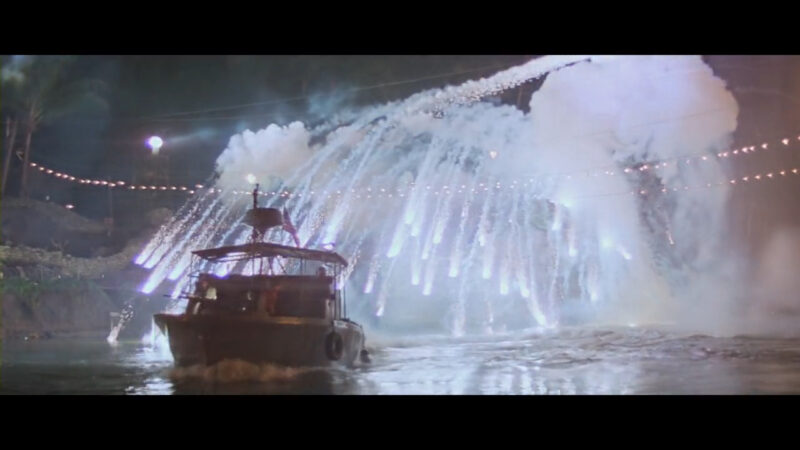
The river
The river that travels from South Vietnam into Cambodia serves as a symbolic pathway, leading the characters and the audience alike on a journey from the realms of civilization into the heart of savagery and chaos. Physically, the river provides a navigable route through the dense, impenetrable jungle, a path for the military boat carrying Captain Willard and his crew. But the river’s function transcends the literal—it’s the backbone of the narrative, reflecting the plot’s progression and the characters’ transformation.
The journey along the river is a descent into the moral and psychological abyss. With each passing bend, the protagonists drift further from the vestiges of civilization and deeper into the savage heart of the jungle. The river’s route reflects the narrative’s trajectory—from order to chaos, sanity to madness, civilization to savagery. It is, in essence, a river of consciousness, charting the course of the human psyche as it navigates the tumultuous waters of morality, sanity, and self.
The river, with its relentless flow, also represents the inexorable passage of time and the relentless nature of war. It’s both a life-giving force, nurturing the jungles and villages along its banks, and a harbinger of death, leading the characters towards their grim fate. This duality mirrors the paradoxical nature of war and human savagery—both destructive and, in a twisted sense, creative, giving rise to new, albeit chaotic, orders and structures.
The river’s changing conditions—from calm to turbulent—mirrors the film’s shifting moods and the characters’ fluctuating mental states. The moments of calm and tranquility are invariably disrupted by bouts of violence and chaos, reinforcing the pervasive sense of unease and instability. The river’s unpredictability underscores the unpredictability of war and the human condition—calm one moment, turbulent the next.
Finally, the river in Apocalypse Now is a boundary and a threshold, separating the known from the unknown, the civilized world from the wild jungle. As the characters cross this boundary, they’re forced to confront the savagery and chaos that lie within themselves and the world around them. The river, therefore, is not just a geographical feature—it’s a psychological and philosophical symbol, reflecting the tumultuous journey as he Willard navigates the horrors of war.
Army face paint
The use of face paint is a notable motif in Apocalypse Now, illustrating a transition from civilization to savagery as the narrative unfolds. The paint serves as an external manifestation of the internal transformation of the characters—Lance, Kurtz, and Willard—signifying their changing perceptions of war, morality, and identity.
For Lance, a surfer-turned-soldier, the application of face paint begins as an innocent act, almost playful, reflecting his naïveté and detachment from the harsh realities of war. He uses vibrant colors and patterns, suggesting a lack of understanding of the brutal nature of his surroundings. His face paint, initially, is more of a game, a child playing war, than a sign of his metamorphosis.
As we move to Kurtz, the face paint takes on a more sinister tone. Kurtz uses dark, stark paint, reflecting his complete transformation from a soldier into a godlike figure who embodies the chaotic savagery of war. His face paint, like his bald head, symbolizes his shedding of societal norms and conventions. It marks his embrace of the inherent chaos and violence within human nature, visually representing his divergence from conventional morality and sanity.
Finally, Willard’s use of face paint signifies his descent into the moral and psychological abyss. He applies the paint as he prepares to confront and kill Kurtz, showing his acceptance of his mission’s brutality. Unlike Lance’s vibrant patterns or Kurtz’s godlike portrayal, Willard’s paint is purely functional, smeared on to camouflage him in the shadows. It marks his journey’s culmination, where he must face his own capacity for violence and savagery to complete his mission.
Helicopters
Helicopters in Apocalypse Now serve as a potent motif, symbolizing the destructive force of war and the paradoxical detachment from its realities. The opening scene featuring the helicopters is pivotal in establishing this motif, setting the tone for the film’s exploration of the impact of war on both individuals and the environment.
The film opens with a serene, almost surreal, landscape—palm trees swaying gently in the wind against a backdrop of a tranquil sky. This peaceful scene is abruptly shattered by the deafening roar of helicopters, followed by a devastating napalm attack. The sound of helicopters is then intercut with the bedroom fan of Willard’s apartment. The stark contrast between the serene landscape and the ensuing chaos encapsulates the invasive and destructive nature of war, both physically (in the case of the bombings) and mentally (in the case of Willard’s psyche). The helicopters, in this scene, embody the intrusion of violence into peaceful spaces, disrupting the natural order and causing irreversible damage.
Beyond destruction, helicopters in Apocalypse Now also represent the impersonal nature of modern warfare. From their aerial vantage point, the characters view the war-torn landscape with a degree of detachment. The violence and destruction become abstracted, reducing the people and landscapes below to mere targets. This detachment from the ground reality echoes the dehumanizing effects of war, blurring the lines between combatants and non-combatants, right and wrong.
Additionally, the helicopter motif speaks to the overpowering presence of military technology in warfare. The thundering sound of the helicopter blades, often drowning out human voices, symbolizes the overriding and dehumanizing force of technology in the theater of war. It reflects how human life and personal narratives are overshadowed by the mechanical, impersonal machinery of war.
As Apocalypse Now progresses, the motif of helicopters evolves from merely instruments of destruction to symbols of absurdity and irrationality. The notorious “Ride of the Valkyries” scene, where helicopters attack a village to the soundtrack of Wagner’s opera, underscores the irrationality and theatricality of war. The incongruous pairing of music and violence amplifies the sense of absurdity and chaos inherent in the narrative.
Face statues
The face statues in Kurtz’s compound are haunting motifs in Apocalypse Now, symbolizing a multitude of concepts from power to the nature of human savagery. The statues reflect an ancient, primal civilization, suggesting a regression from the modern world’s order and laws. The crudeness of their features, coupled with their giant scale, infuses a sense of raw, unfiltered power. Kurtz’s decision to surround himself with these figures indicates his desire to position himself as a godlike entity, away from the confines of societal norms and regulations. They amplify his character’s omnipotence within his microcosmic society, creating a quasi-religious environment where he is the object of worship and fear.
These statues also depict a transformation of humanity’s face in the context of war and savagery. They do not exhibit refined or civilized traits but instead demonstrate rough, primal expressions. The intensity of their expressions captures the profound transformation individuals undergo when exposed to extreme conditions of war, almost a de-evolution into a more primal state. This mirrors the narrative arc of characters like Kurtz and even Willard, to an extent, as they confront their innermost savagery.
These face statues serve as silent witnesses to the atrocities committed in the compound. Their perpetual gaze reflects the enduring impact of violence and cruelty, a constant reminder of the human capacity for savagery. They serve as tangible evidence of the brutal reality of war.
The jungle
The jungle in Apocalypse Now represents the wild, untamed aspects of human nature. It serves as a stark contrast to the structured, ordered world of civilization, embodying the chaos and savagery that civilization seeks to suppress. As the characters traverse the jungle, they confront not only its physical dangers but also the psychological threat it poses. The dense, unfathomable wilderness mirrors the complexities of the human psyche, challenging the characters’ notions of sanity and morality. By placing them in an environment where the rules of civilization no longer apply, the jungle forces the characters to confront their inherent savagery and capacity for violence.
Darkness
Darkness is a recurring motif that encapsulates several of the film’s central themes. It symbolizes the moral and psychological ambiguity that pervades the narrative, mirroring the dark aspects of human nature that the film explores. Darkness often shrouds scenes of violence and madness, obscuring the line between good and evil, sanity and insanity. It provides a visual representation of the protagonist’s internal struggle, reflecting his descent into the moral and psychological abyss. Darkness, in Apocalypse Now, is not merely the absence of light—it’s the presence of chaos within us all.
The fog
The fog motif in Apocalypse Now often accompanies the characters’ journey into the unknown. It represents the uncertainty and ambiguity that underlie their mission and their understanding of morality and sanity. As the characters navigate the foggy landscapes, they’re also navigating their moral ambiguities and psychological complexities. The fog obscures their vision, making it difficult to discern friend from foe, right from wrong. It reflects the characters’ confusion and doubt, signifying the blurry lines between civilization and savagery, sanity and madness, and morality and immorality.
The map
The map is another significant motif in Apocalypse Now. As a symbol of civilization and order, the map is supposed to guide the characters through the chaotic landscape of Vietnam. However, as the narrative progresses, the map becomes increasingly irrelevant. The map’s failure to accurately represent the complex reality of the jungle and the river underscores the film’s exploration of the paradox of civilization. It suggests that the constructs and structures of civilization are inadequate in navigating the chaos and savagery inherent in human nature.
The bridge
The bridge in Apocalypse Now is a significant motif, symbolizing the fragile boundary between civilization and savagery. It’s a point of conflict, a structure that is built every day and destroyed every night, reflecting the futile cycle of creation and destruction in war. The bridge’s transitory nature underscores the impermanence and futility of structures and orders imposed upon the chaotic reality of war. It reflects the inevitable erosion of civilization in the face of inherent savagery and the destructive power of war.
Questions & answers about Apocalypse Now
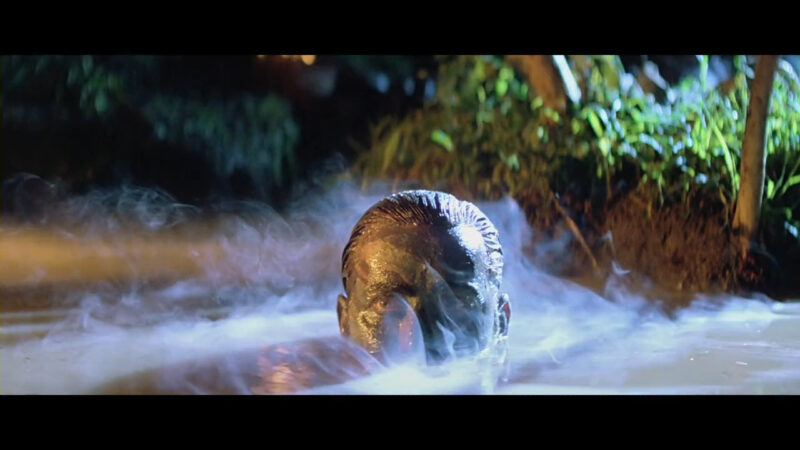
What happens to Lance’s mind?
Lance, one of the soldiers aboard the PBR who embarks on the mission with Willard, undergoes a striking transformation throughout Apocalypse Now. His transformation into what could be perceived as “crazy” is a significant aspect of the film’s exploration of the war’s impact on the human psyche and the theme of the duality of man.
In the beginning, Lance is depicted as a naive, innocent young man, completely out of place in the setting of war. He is initially introduced as a surfer from California, underscoring his disconnection from the grim realities of the Vietnam War. His innocence and initial obliviousness to the darker aspects of their mission highlight the theme of duality—the capacity for both innocence and brutality within man.
As the film progresses and the crew moves deeper into the jungle, Lance’s behavior starts to change dramatically. He begins to display erratic behavior, becomes detached from reality, and is seemingly drawn to the primal, chaotic elements of their surroundings. This shift can be understood as a psychological reaction to the brutal realities of war and the intense, often absurd situations he finds himself in.
His donning of face paint and adopting tribal accessories signify his gradual descent into a kind of madness. It’s as if he’s immersing himself in the primal, chaotic world around him as a means to cope with the horrors of war. This transformation also visually underscores the theme of duality, as Lance shifts from the role of an innocent surfer to a figure that seems to embrace savagery.
Why do the Montagnards let Willard leave?
At the end of Apocalypse Now, Willard kills Kurtz, takes Lance, and leaves the compound, while the Montagnards— the indigenous tribe loyal to Kurtz— watch without interference. The reason behind their non-intervention can be attributed to several factors tied to the film’s overarching themes.
The most significant reason relates to the symbolic power dynamic that Kurtz held over the Montagnards. Kurtz was perceived by them as a god-like figure, commanding absolute authority and reverence. His brutal and fearless persona had earned their respect, and they accepted him as their leader. Therefore, when Willard kills Kurtz, he symbolically takes on the power and authority of Kurtz.
Willard standing above the crowd, drenched in water and blood, creates an image of a warrior, a god-like figure, much like Kurtz was to them. In their eyes, Willard might be seen as a worthy successor to Kurtz, or at least a force powerful enough to have defeated him. As a result, they permit him to leave.
This is a crucial moment in Apocalypse Now, for it signifies a final shift in Willard’s journey. Throughout the film, Willard grapples with the violent and chaotic elements of war, constantly encountering the question of what it means to retain one’s humanity amidst such brutality. By the end, he’s faced with the choice to become a new Kurtz or to reject this path of darkness.
His decision to take Lance and leave indicates his refusal to succumb to the savagery that consumed Kurtz. It represents his ultimate choice not to become another Kurtz, even though he’s seen as such by the Montagnards. The tribe’s decision to let him go reinforces this narrative, culminating Willard’s exploration of the self.
Now it’s your turn
Have more unanswered questions about Apocalypse Now? Are there themes or motifs we missed? Is there more to explain about the ending? Please post your questions and thoughts in the comments section! We’ll do our best to address every one of them. If we like what you have to say, you could become part of our movie guide!

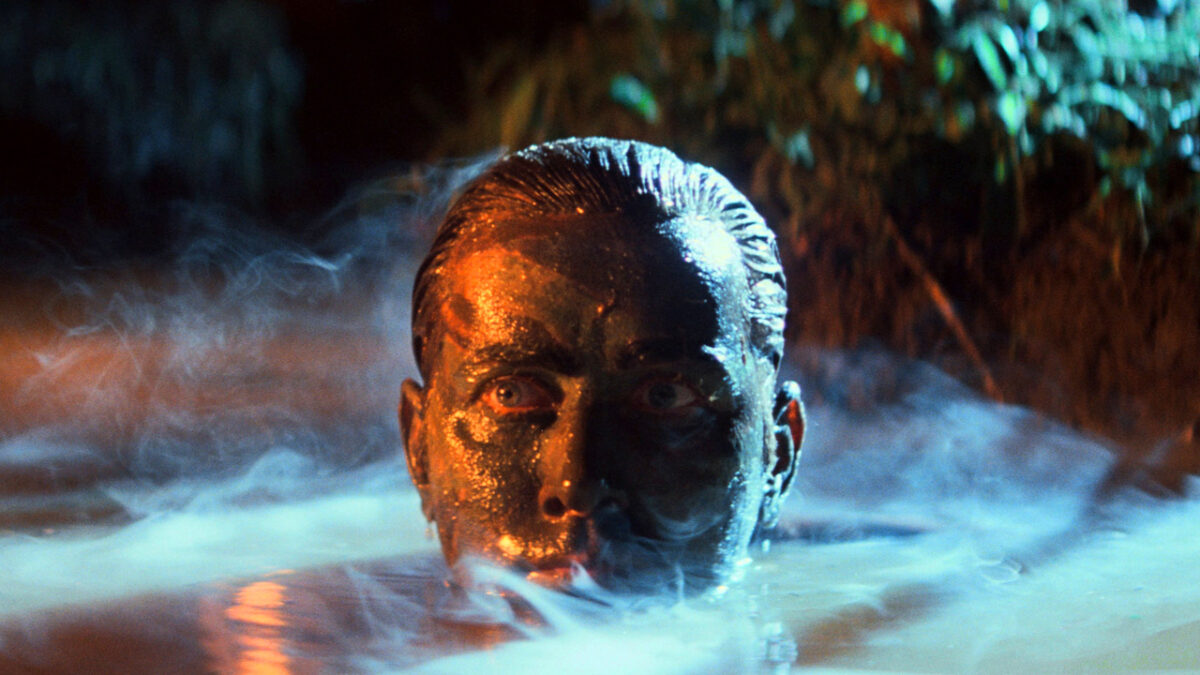
The movie imho is about purpose (especially if you understand purpose as how to contextualise yourself with the surrounding). Willard cant find meaning being at home not in the hotel room but only when being on a mission. And he will be bereft of it, as it is his last task. So, he will be lost. Kilgore provides hollow purpose. Kurtz is looking for purpose and went extreme. Even the photographer looked for it, wandering around in the region only to find purpose with Kurtz. Sadly, the only people (other than Charlie) to have a “real” purpose are the French, but we know how this ends.. So in the end, the movie is about pursuing the good course/ purpose as a decent human being although knowing you’ll be lost (like W himself or the French).